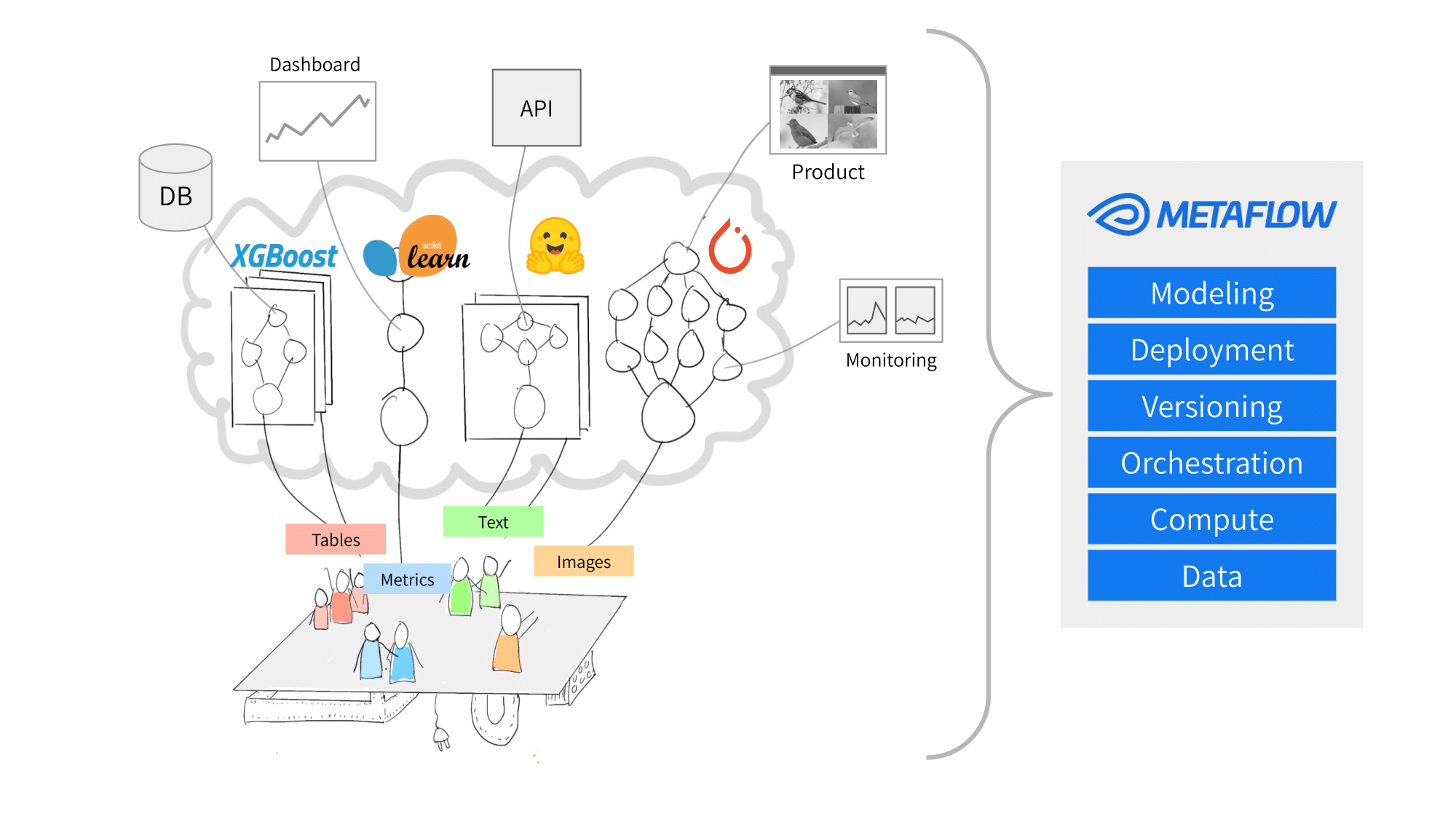Streamlining ML Workflows with Metaflow

Unlocking Efficient Machine Learning with Metaflow
Machine learning workflows can be complex and time-consuming, involving multiple tasks such as data preprocessing, model training, and deployment. However, with the right tools, these workflows can be streamlined, making ML more efficient and accessible. Enter Metaflow, an open-source Python library designed to simplify and manage ML, AI, and data science projects.
What is Metaflow?
Metaflow is an open-source Python library for building and managing ML, AI, and data science projects. It provides a robust framework for modeling, deployment, versioning, orchestration, and more, allowing data scientists and ML engineers to focus on building high-quality models rather than managing infrastructure.
Key Features of Metaflow
- Modeling: Metaflow supports various ML frameworks, including TensorFlow, PyTorch, and Scikit-Learn, allowing you to build and train models using your preferred library.
- Deployment: Easily deploy models to production environments, including cloud services like AWS and Azure.
- Versioning: Track changes to your models, data, and code, ensuring reproducibility and collaboration.
- Orchestration: Automate workflows, including data processing, model training, and deployment, using Metaflow's built-in orchestration engine.
By leveraging Metaflow's comprehensive features, you can streamline your ML workflows, reduce errors, and increase productivity. In the next section, we will delve into how to get started with Metaflow and explore its capabilities in more detail.
Key Features and Benefits of Metaflow
Metaflow is a powerful tool for streamlining ML workflows, offering several key features and benefits that make it an ideal choice for data scientists and engineers. Some of the most significant advantages of using Metaflow include:
- Human-friendly Python library for data scientists and engineers. Metaflow provides an intuitive and easy-to-use interface, allowing users to focus on building and deploying ML models without worrying about the underlying infrastructure.
- Simplifies development, deployment, and operation of data science projects. With Metaflow, users can easily manage the entire ML lifecycle, from data preparation to model deployment, in a single, unified platform.
- Unified API for accessing various tools and services. Metaflow provides a single API for accessing a wide range of tools and services, making it easy to integrate with existing workflows and tools.
Getting Started with Metaflow
Metaflow is an open-source framework that streamlines machine learning workflows, making it easier to build, manage, and scale ML projects. To start using Metaflow, follow these steps:
1. Installation
Install Metaflow using Python 3 (note that Python 2.7 is supported for legacy applications). You can install Metaflow using pip:
pip install metaflow
This command will install Metaflow and its dependencies. Once installed, you can verify the installation by running:
metaflow --version
2. Explore Tutorials and Documentation
Metaflow provides extensive tutorials and documentation to help you get started. The official Metaflow website has a wealth of resources, including:
- Tutorials: Step-by-step guides to help you learn Metaflow's core concepts and features.
- Documentation: Detailed documentation covering Metaflow's API, configuration options, and more.
- Examples: A collection of example projects demonstrating Metaflow's capabilities.
By exploring these resources, you'll be well on your way to mastering Metaflow and streamlining your ML workflows.
Best Practices for Machine Learning with Metaflow
Metaflow is a powerful tool for streamlining machine learning (ML) workflows, offering a robust and scalable solution for data scientists and ML engineers. To ensure optimal usage and maximize efficiency, follow these best practices:
Leverage Metaflow's sandbox environment for testing and development
Take advantage of Metaflow's sandbox environment to test and develop your ML workflows without affecting production environments. This allows for safe experimentation, rapid prototyping, and debugging, ensuring that your workflows are robust and reliable before deploying them to production.
Follow Metaflow's documentation and tutorials for optimal usage
Metaflow provides extensive documentation and tutorials that cover everything from basic to advanced topics. Thoroughly reviewing these resources will help you understand how to effectively utilize Metaflow's features and integrate them into your ML workflows.
Conclusion: Revolutionizing ML Workflows with Metaflow
As we conclude our comprehensive guide to streamlining ML workflows with Metaflow, it's clear that this innovative tool is revolutionizing the way data scientists and engineers approach machine learning. With its powerful features and robust architecture, Metaflow is empowering teams to boost productivity, enhance collaboration, and accelerate the deployment of ML models.
Unlocking Productivity Gains
Metaflow is a powerful tool for streamlining ML workflows and boosting productivity. By automating repetitive tasks, providing a unified interface for ML workflows, and enabling seamless collaboration, Metaflow helps data scientists and engineers focus on high-value tasks like model development and experimentation. With Metaflow, teams can achieve faster experiment cycles, improved model accuracy, and enhanced overall efficiency.
A Reliable Choice for Data Scientists and Engineers
Metaflow's open-source nature and Netflix backing make it a reliable choice for data scientists and engineers. The fact that it's open-source ensures that the community contributes to its growth and improvement, while Netflix's involvement provides a level of credibility and trustworthiness. This unique combination makes Metaflow an attractive choice for teams looking for a robust and scalable ML workflow solution.
In conclusion, Metaflow is poised to revolutionize ML workflows by providing a comprehensive, scalable, and reliable solution for data scientists and engineers. By embracing Metaflow, teams can unlock new levels of productivity, collaboration, and innovation, ultimately driving business value and success.










Comments ()